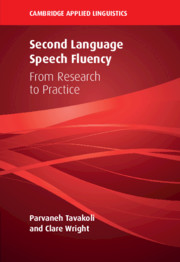36 results
Assessing the healthcare epidemiology environment—A roadmap for SHEA’s future
-
- Journal:
- Infection Control & Hospital Epidemiology / Volume 42 / Issue 9 / September 2021
- Published online by Cambridge University Press:
- 18 June 2021, pp. 1111-1114
- Print publication:
- September 2021
-
- Article
- Export citation
Local, state and federal face mask mandates during the COVID-19 pandemic
-
- Journal:
- Infection Control & Hospital Epidemiology / Volume 42 / Issue 4 / April 2021
- Published online by Cambridge University Press:
- 05 January 2021, pp. 455-456
- Print publication:
- April 2021
-
- Article
-
- You have access
- Open access
- HTML
- Export citation
4 - Fluency in Second Language Task-Based Research
-
- Book:
- Second Language Speech Fluency
- Published online:
- 15 December 2020
- Print publication:
- 17 December 2020, pp 64-83
-
- Chapter
- Export citation
2 - Fluency from a Psycholinguistic Perspective
-
- Book:
- Second Language Speech Fluency
- Published online:
- 15 December 2020
- Print publication:
- 17 December 2020, pp 22-42
-
- Chapter
- Export citation
5 - Fluency in Second Language Pedagogy
-
- Book:
- Second Language Speech Fluency
- Published online:
- 15 December 2020
- Print publication:
- 17 December 2020, pp 84-102
-
- Chapter
- Export citation
Tables
-
- Book:
- Second Language Speech Fluency
- Published online:
- 15 December 2020
- Print publication:
- 17 December 2020, pp ix-x
-
- Chapter
- Export citation
8 - Conclusion
-
- Book:
- Second Language Speech Fluency
- Published online:
- 15 December 2020
- Print publication:
- 17 December 2020, pp 146-157
-
- Chapter
- Export citation
Appendix: - Fluency Descriptors across Time
-
- Book:
- Second Language Speech Fluency
- Published online:
- 15 December 2020
- Print publication:
- 17 December 2020, pp 158-161
-
- Chapter
- Export citation
Subject Index
-
- Book:
- Second Language Speech Fluency
- Published online:
- 15 December 2020
- Print publication:
- 17 December 2020, pp 188-190
-
- Chapter
- Export citation
Contents
-
- Book:
- Second Language Speech Fluency
- Published online:
- 15 December 2020
- Print publication:
- 17 December 2020, pp vii-vii
-
- Chapter
- Export citation
7 - Fluency in Different Contexts
-
- Book:
- Second Language Speech Fluency
- Published online:
- 15 December 2020
- Print publication:
- 17 December 2020, pp 124-145
-
- Chapter
- Export citation
Copyright page
-
- Book:
- Second Language Speech Fluency
- Published online:
- 15 December 2020
- Print publication:
- 17 December 2020, pp iv-iv
-
- Chapter
- Export citation
Author Index
-
- Book:
- Second Language Speech Fluency
- Published online:
- 15 December 2020
- Print publication:
- 17 December 2020, pp 187-187
-
- Chapter
- Export citation
3 - Measuring Fluency
-
- Book:
- Second Language Speech Fluency
- Published online:
- 15 December 2020
- Print publication:
- 17 December 2020, pp 43-63
-
- Chapter
- Export citation
References
-
- Book:
- Second Language Speech Fluency
- Published online:
- 15 December 2020
- Print publication:
- 17 December 2020, pp 162-186
-
- Chapter
- Export citation
1 - Introduction
-
- Book:
- Second Language Speech Fluency
- Published online:
- 15 December 2020
- Print publication:
- 17 December 2020, pp 1-21
-
- Chapter
- Export citation
Dedication
-
- Book:
- Second Language Speech Fluency
- Published online:
- 15 December 2020
- Print publication:
- 17 December 2020, pp v-vi
-
- Chapter
- Export citation
Figures
-
- Book:
- Second Language Speech Fluency
- Published online:
- 15 December 2020
- Print publication:
- 17 December 2020, pp viii-viii
-
- Chapter
- Export citation
6 - Fluency in Second Language Testing
-
- Book:
- Second Language Speech Fluency
- Published online:
- 15 December 2020
- Print publication:
- 17 December 2020, pp 103-123
-
- Chapter
- Export citation

Second Language Speech Fluency
- From Research to Practice
-
- Published online:
- 15 December 2020
- Print publication:
- 17 December 2020



